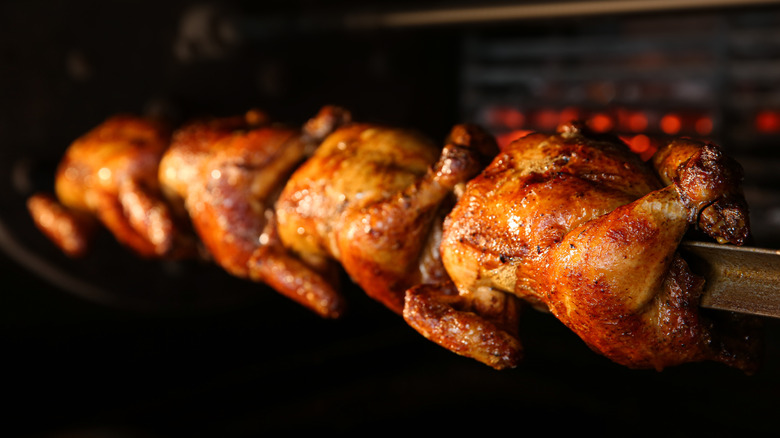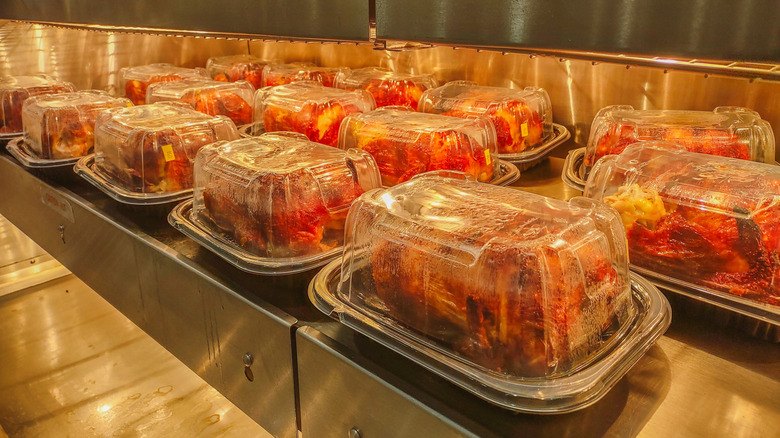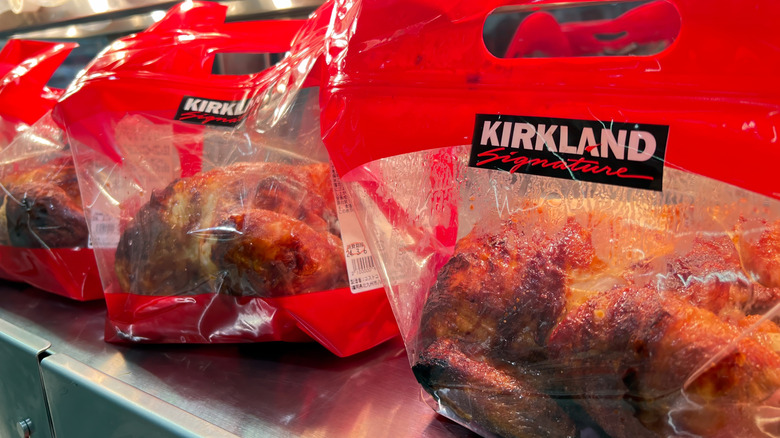Here's Why Grocery Store Rotisserie Chickens Are Cheaper Than Raw Chickens
According to the USDA Economic Research Service, food prices (including grocery stores and restaurants) increased 5.8% year-over-year in 2023, with many supermarket categories continuing to rise in 2024. Hoping to save money, many people look to cooking from scratch, since prepared foods generally cost more. Making a basic but foolproof roasted chicken seems like a great place to start. But it turns out a fully cooked grocery store deli rotisserie chicken is actually cheaper than a whole, fresh chicken from the meat department. (Go ahead and check this out for yourself.)
By the end of 2024, at a Safeway in Portland, Oregon, a hot rotisserie chicken cost about $10. Meanwhile, a whole, raw chicken cost between $13 and $18. But why? After all, the rotisserie version involves not only more human labor and electricity to prepare, it also features a slew of seasonings and cooking oils. Well, in some cases the price difference at stores can reflect how close the birds likely are to their expiration dates.
Rotisserie chickens aren't subpar chickens
The gist of this particular price difference comes from the fact that grocery stores try to abide by printed sell-by dates, whether those are closed or open expiration dates. For most perishable goods, the open "best if used by/before" date estimates the final day a food is at its best quality — not when it's no longer edible. As former Trader Joe's CEO Doug Rauch told the New York Times in 2013, rather than toss out perfectly good meat, bread, or produce, grocery stores commonly repurpose these foods into ready-to-eat salads, noodle dishes, fried chicken, and — yes, in some cases, rotisserie chicken.
Since those whole, raw chickens are still safe to eat when they hit their sell-by date, it makes sense for stores to do something with them to incentivize buyers. Enter the rotisserie. Many larger grocery stores these days have in-store commercial ovens dedicated to cooking rotisserie chickens. But rather than sell them at a premium, prepared deli foods sell at lower prices to both use up surplus and attract customers. One PBS survey found significant price differences between raw and rotisserie at several grocery stores.
But as you browse the best and worst grocery store rotisserie chickens, it's important to remember the other factors affecting price differences. Rotisserie chickens must be uniform in size to maximize the spits and packaging, so they tend to be on the smaller, less expensive side. In addition, it's unlikely stores are using the most expensive, organic birds off the shelves for that deli chicken salad.
How rotisserie chicken got so cheap that the customer's gain became the retailer's loss
Back in 1994, Supermarket News reported on a sudden rise in demand for rotisserie chickens, noting the popularity, at the time, of Boston Market and Kenny Rogers Roasters restaurants, both of which leaned heavily on roasted chicken. The publication reported increased grocery store rotisserie chicken sales of up to 30% over the previous four months. Stores responded quickly with expanded service, seasonings, and production. One store owner even speculated on whether the newfound popularity was just a fad.
Clearly, spit-roasted poultry is still popular. Costco's rotisserie chicken is so popular that in 2023, Costco shoppers gobbled up 137 million roasted birds. The warehouse club also manages its rotisserie chicken differently, using a dedicated supply chain rather than expiring stock. The company sources chickens from a single producer, which marinates them in advance and ships them to stores, ready to be roasted. At a price point around $5, the chicken becomes what's known as a loss leader for the company, luring shoppers in the door where they'll likely fill up their cart with other items — and hike up their tab. While they might lack the infrastructure of Costco's massive poultry operation, many other retailers, including Canada's Rowe Farms, price rotisserie chickens using this strategy (via CBC).
While the price of whole, raw chickens may fluctuate as market prices rise and fall, the price of grocery store rotisserie chicken has stayed fairly stable over the past 30 years. One retailer told Supermarket News back in '94 that his store was raising its prices from $3.99 to $4.39 per rotisserie chicken. That translates to about $9.31 today, or just about what Portland's Safeway chicken sells for today.


